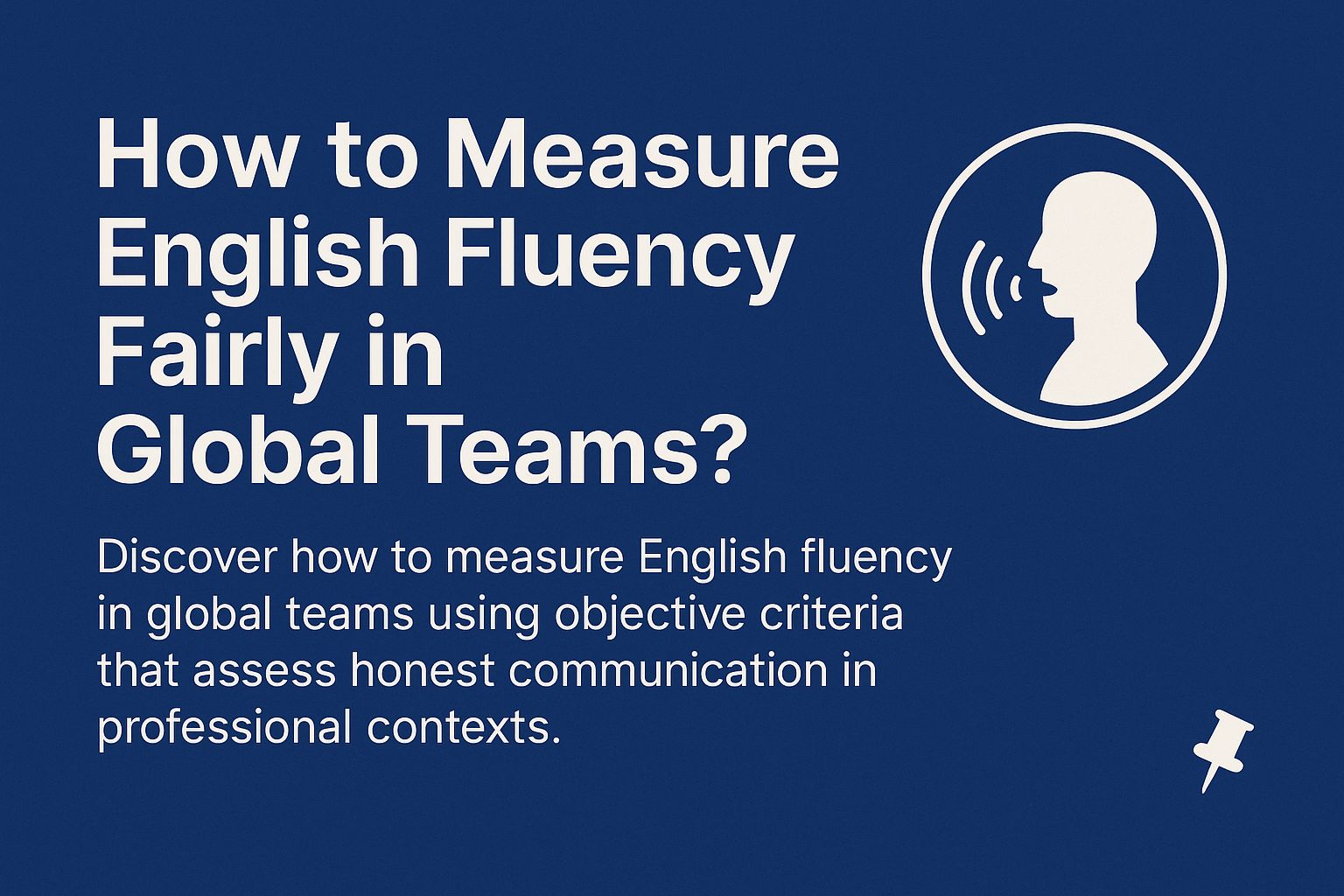Discover how to measure English fluency in global teams using objective criteria that assess honest communication in professional contexts.
With the rise of remote work, company internationalization, and cultural diversity within teams, English fluency is no longer just a hiring requirement — it has become a strategic asset for collaboration across regions.
However, evaluating fluency in global teams is a real challenge.
How can we ensure fairness when each team member has a different accent, background, and context?
How can we measure someone’s ability to communicate in English clearly and effectively, without relying on subjective judgment?
This article explores how to make English fluency assessment more fair, standardized, and intelligent, and explains why this issue is urgent for companies that want to stay competitive in international environments.
Fluency Means Being Understood — Not Just Speaking English
English fluency isn’t about speaking fast or speaking without errors.
It’s about the ability to express yourself clearly, naturally, and confidently — even if your vocabulary is simple or there are minor grammar slips.
A fluent speaker can:
- Participate in meetings with cohesion and agility
- Solve problems verbally
- Interact with colleagues from different countries
- Adapt their English to the context (informal, technical, institutional)
- Keep conversations flowing without getting stuck
In other words, fluency is functional, not perfect.
That’s why it must be assessed in a way that reflects reality, especially in multicultural teams where diverse accents, experiences, and communication styles coexist.
The Problem with Subjective Evaluation
Traditionally, fluency assessment in companies is done informally.
Managers judge speaking ability during interviews, peers form opinions during meetings, and sometimes, written tests are used as a reference for “level.”
This approach has severe limitations:
- Subjectivity: What one evaluator sees as “good English” may differ from another’s view.
- Cultural bias: Accents are often mistaken for a lack of fluency.
- Lack of standardization: Each team or recruiter may use different criteria.
- Infrequent assessment: Fluency is often evaluated only at the hiring point, never again.
In global teams, these issues are amplified.
Misunderstandings arise without fair and objective criteria, talents feel discouraged, and flawed decisions may follow.
What Does a Fair Fluency Assessment Look Like?
A fair English fluency assessment should rely on criteria that are:
- Focused on the communication function, not just the form
- Relevant to professional contexts (e.g., meetings, presentations, negotiations)
- Adaptable to different accents and linguistic backgrounds
- Measurable, repeatable, and objective
A fair assessment doesn’t look for “textbook English.”
It aims to evaluate a person’s ability to:
- Formulate ideas quickly
- Deliver clear messages
- Adapt language to the audience and context
- Actively listen and respond appropriately in real time
The good news?
Thanks to technology, it’s already possible to perform this evaluation objectively and at scale.
The Role of Technology in Speaking Assessment
The use of artificial intelligence in language teaching and assessment has advanced significantly, especially when evaluating speaking, the most complex and subjective skill.
Traditionally, fluency evaluation required time, one-on-one observation, and expert judgment, making it difficult to scale and prone to personal bias.
Today, companies can analyze real voice recordings automatically and accurately with AI.
Advanced tools can evaluate:
- Response time
- Lexical richness
- Pronunciation clarity
- Context-appropriate intonation
- Overall fluency
These evaluations rely on consistent linguistic parameters, delivering standardized, transparent, and replicable results.
The real breakthrough lies in eliminating dependence on human perception, often influenced by empathy, personal preferences, or unconscious bias toward accents, and replacing it with an evidence-based, impartial process.
In addition, automated speaking tests allow for frequent, fast, and scalable evaluations across entire teams — ideal for companies with international operations, remote teams, or high turnover.
Benefits for HR, Leadership, and Culture
Implementing a structured English fluency assessment brings measurable benefits across departments:
For HR:
- More accurate candidate selection
- Real data to guide development plans
- Less bias in recruitment and evaluation
For Leadership:
- Identify talent for global or client-facing roles
- Diagnose communication bottlenecks in teams
- Plan training based on real needs
For Company Culture:
- Promote linguistic diversity and inclusion
- Use transparent and fair evaluation standards
- Foster an environment where everyone communicates confidently
Rather than reinforcing stereotypes about “good English,” the organization shifts toward data, clarity, and merit, which impacts both inclusion and performance. According to the OECD, fair communication assessments are key to identifying and developing talent in modern workplaces.
How to Start Measuring Fluency Consistently
The first step is to review how your organization currently evaluates fluency.
If it’s only measured in interviews or based on outdated certificates, it’s time to rethink.
Next, choose a speaking assessment tool that is:
- Scalable — works across departments and volumes
- Objective — based on clear linguistic criteria
- Culturally neutral — evaluates communication, not accent
- Integrated — fits into hiring, onboarding, and development flows
Conclusion
Fairly measuring English fluency means recognizing that every person has their speaking style, cultural background, and learning journey.
However, all should be evaluated using the same clear standards and tools that reward communication, not surface impressions.
Companies that understand this will lead the way.
They build better-prepared teams, more efficient processes, and workplaces where English is a bridge, not a barrier.
If your team speaks English, it’s time to ask:
How well do they speak it — and how much does that fluency impact your results?




